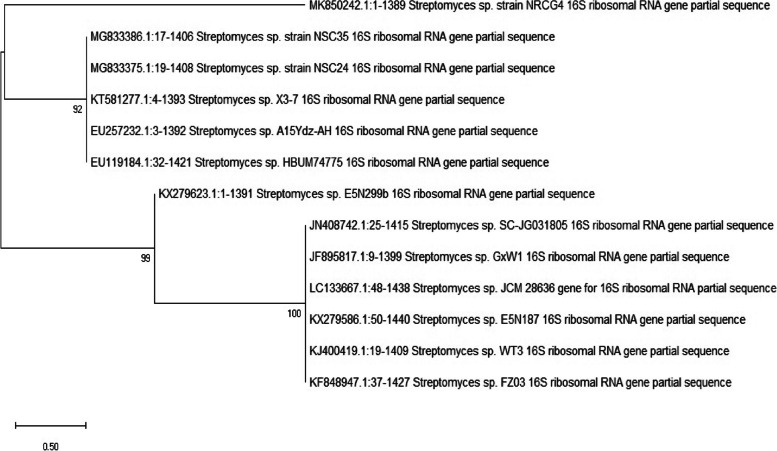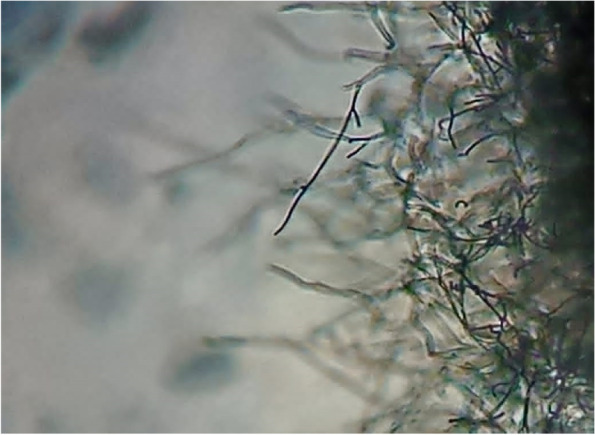Characterization of biologically active exopolysaccharide produced by Streptomyces sp. NRCG4 and its anti-Alzheimer efficacy: in-vitro targets
IF 3.5
Q3 Biochemistry, Genetics and Molecular Biology
Journal of Genetic Engineering and Biotechnology
Pub Date : 2023-12-01
DOI:10.1186/s43141-023-00530-9
引用次数: 0
Abstract
Background
Exopolysaccharides are extremely powerful molecules with a wide range of uses in pharmaceuticals due to their structural and compositional complexity. Marine microorganisms often produce bioactive substances with novel functions and structures because of their special living conditions. Polysaccharides from marine microorganisms are of interest to new drug discovery.
Results
The current research focused on the isolation of bacteria from Red Sea, Egypt, that have the ability to produce a new natural exopolysaccharide in order to be examined in treating Alzheimer’s illness to obviate side effects of synthetic drugs. Properties of exopolysaccharide (EPS) produced by an isolated Streptomyces strain were investigated for its capability to play as anti-Alzheimer. This strain was identified morphologically, physiologically, and biochemically and actually was confirmed by molecularly 16S rRNA analysis as Streptomyces sp. NRCG4 with accession number MK850242. The produced EPS was fractionated by precipitation 1:4 volumes of chilled ethanol and the third major fraction (1:3) listed as NRCG4, and then the functional groups, MW, and chemical evaluation have been detected via Fourier-transform infrared (FTIR), high-performance gel permeation chromatography (HPGPC), and high-performance liquid chromatography (HPLC). The findings showed that NRCG4 was an acidic EPS composed of mannuronic acid, glucose, mannose, and rhamnose in a molar ratio of 1.2:1.5:2.8:1.0, respectively. NRCG4 Mw was determined to be 4.25 × 105 gmol−1 and the Mn to be 1.97 × 105 gmol−1. Also, the NRCG4 included uronic acid (16.0%) and sulfate (0.0%), but no protein was found. In addition, antioxidant and anti-inflammation activity was measured through various methods. This study confirmed that NRCG4 exopolysaccharide exerted anti-Alzheimer’s characters via inhibition of cholinesterase and tyrosinase as well as anti-inflammatory and antioxidant abilities. Additionally, it occurred a potential role in the suppression of Alzheimer’s disease risk factors through its antioxidant (metal chelation, radical scavenging capability), anti-tyrosinase and anti-inflammatory characteristics. The anti-Alzheimer’s disease efficacy of NRCG4 exopolysaccharide may be assigned to its unique determined chemical composition.
Conclusions
The present study highlighted those exopolysaccharides could be harnessed to improve pharmaceutical industry (anti-Alzheimer, anti-tyrosinase, anti-inflammatory, and antioxidant agents).



Streptomyces sp. NRCG4产生的生物活性外多糖的表征及其抗阿尔茨海默病的功效:体外靶点。
背景:胞外多糖是一种非常强大的分子,由于其结构和组成的复杂性,在药物中有着广泛的应用。海洋微生物由于其特殊的生存条件,经常产生具有新颖功能和结构的生物活性物质。从海洋微生物中提取的多糖对新药开发具有重要意义。结果:目前的研究重点是从埃及红海分离出一种能够产生一种新的天然胞外多糖的细菌,以研究其在治疗阿尔茨海默病方面的作用,以消除合成药物的副作用。研究了一株链霉菌分离株产生的胞外多糖(EPS)的抗阿尔茨海默病能力。经形态学、生理和生化鉴定,分子16S rRNA鉴定为Streptomyces sp. NRCG4,菌株编号MK850242。以1:4体积的冷冻乙醇对EPS进行分离,将第3部分(1:3)记为NRCG4,并通过傅里叶变换红外(FTIR)、高效凝胶渗透色谱(HPGPC)和高效液相色谱(HPLC)检测EPS的官能团、分子量和化学性质。结果表明,NRCG4是一种由甘露糖酸、葡萄糖、甘露糖和鼠李糖以1.2:1.5:2.8:1.0的摩尔比组成的酸性EPS。NRCG4的分子量为4.25 × 105 gmol-1, Mn为1.97 × 105 gmol-1。NRCG4中含有糖醛酸(16.0%)和硫酸盐(0.0%),但未发现蛋白质。此外,通过各种方法测定其抗氧化和抗炎活性。本研究证实NRCG4外多糖通过抑制胆碱酯酶和酪氨酸酶以及抗炎和抗氧化能力发挥抗阿尔茨海默病的作用。此外,它通过其抗氧化(金属螯合、自由基清除能力)、抗酪氨酸酶和抗炎特性,在抑制阿尔茨海默病危险因素中发挥潜在作用。NRCG4胞外多糖的抗阿尔茨海默病功效可能与其独特的化学成分有关。结论:这些外多糖在抗阿尔茨海默病、抗酪氨酸酶、抗炎、抗氧化等方面具有一定的应用价值。
本文章由计算机程序翻译,如有差异,请以英文原文为准。
求助全文
约1分钟内获得全文
求助全文
来源期刊

Journal of Genetic Engineering and Biotechnology
Biochemistry, Genetics and Molecular Biology-Biotechnology
CiteScore
5.70
自引率
5.70%
发文量
159
审稿时长
16 weeks
期刊介绍:
Journal of genetic engineering and biotechnology is devoted to rapid publication of full-length research papers that leads to significant contribution in advancing knowledge in genetic engineering and biotechnology and provide novel perspectives in this research area. JGEB includes all major themes related to genetic engineering and recombinant DNA. The area of interest of JGEB includes but not restricted to: •Plant genetics •Animal genetics •Bacterial enzymes •Agricultural Biotechnology, •Biochemistry, •Biophysics, •Bioinformatics, •Environmental Biotechnology, •Industrial Biotechnology, •Microbial biotechnology, •Medical Biotechnology, •Bioenergy, Biosafety, •Biosecurity, •Bioethics, •GMOS, •Genomic, •Proteomic JGEB accepts
 求助内容:
求助内容: 应助结果提醒方式:
应助结果提醒方式:


